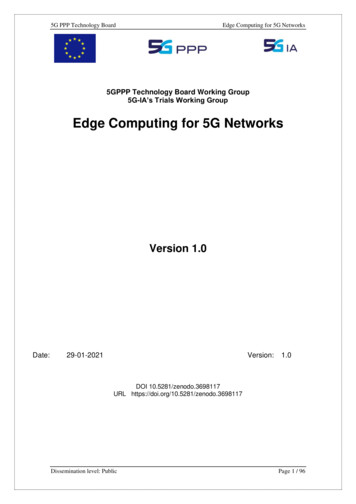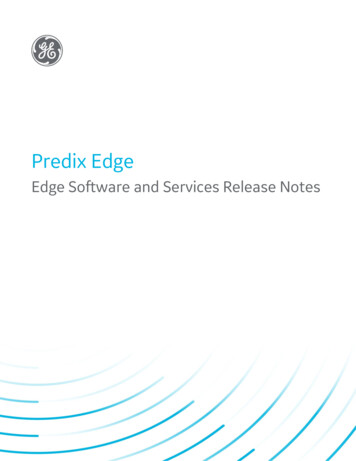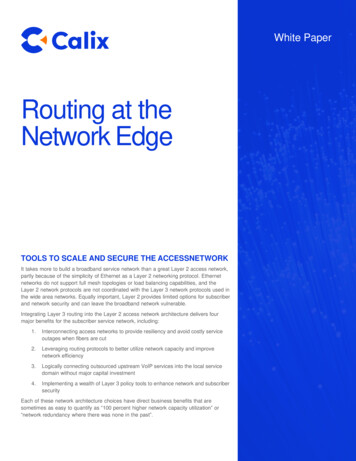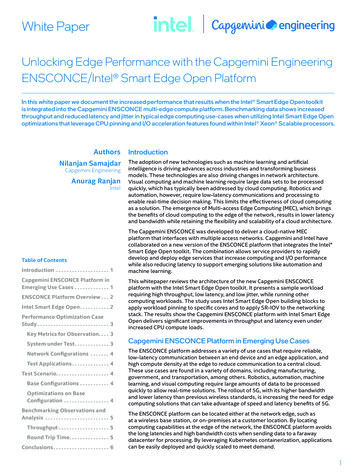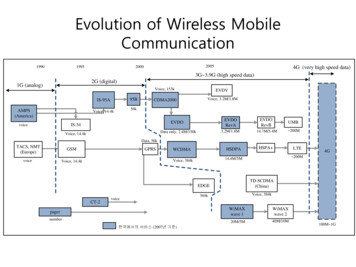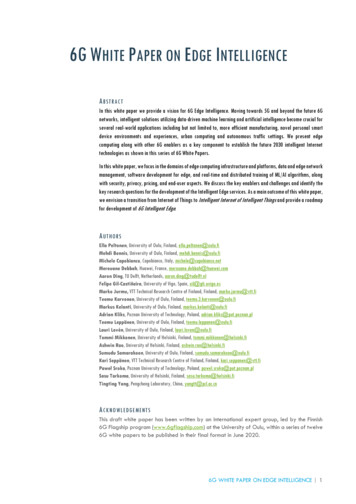
Transcription
6G WHITE PAPER ON EDGE INTELLIGENCEA BSTRACTIn this white paper we provide a vision for 6G Edge Intelligence. Moving towards 5G and beyond the future 6Gnetworks, intelligent solutions utilizing data-driven machine learning and artificial intelligence become crucial forseveral real-world applications including but not limited to, more efficient manufacturing, novel personal smartdevice environments and experiences, urban computing and autonomous traffic settings. We present edgecomputing along with other 6G enablers as a key component to establish the future 2030 intelligent Internettechnologies as shown in this series of 6G White Papers.In this white paper, we focus in the domains of edge computing infrastructure and platforms, data and edge networkmanagement, software development for edge, and real-time and distributed training of ML/AI algorithms, alongwith security, privacy, pricing, and end-user aspects. We discuss the key enablers and challenges and identify thekey research questions for the development of the Intelligent Edge services. As a main outcome of this white paper,we envision a transition from Internet of Things to Intelligent Internet of Intelligent Things and provide a roadmapfor development of 6G Intelligent Edge.A UTHORSElla Peltonen, University of Oulu, Finland, ella.peltonen@oulu.fiMehdi Bennis, University of Oulu, Finland, mehdi.bennis@oulu.fiMichele Capobianco, Capobianco, Italy, michele@capobianco.netMerouane Debbah, Huawei, France, merouane.debbah@huawei.comAaron Ding, TU Delft, Netherlands, aaron.ding@tudelft.nlFelipe Gil-Castiñeira, University of Vigo, Spain, xil@gti.uvigo.esMarko Jurmu, VTT Technical Research Centre of Finland, Finland, marko.jurmu@vtt.fiTeemu Karvonen, University of Oulu, Finland, teemu.3.karvonen@oulu.fiMarkus Kelanti, University of Oulu, Finland, markus.kelanti@oulu.fiAdrian Kliks, Poznan University of Technology, Poland, adrian.kliks@put.poznan.plTeemu Leppänen, University of Oulu, Finland, teemu.leppanen@oulu.fiLauri Lovén, University of Oulu, Finland, lauri.loven@oulu.fiTommi Mikkonen, University of Helsinki, Finland, tommi.mikkonen@helsinki.fiAshwin Rao, University of Helsinki, Finland, ashwin.rao@helsinki.fiSumudu Samarakoon, University of Oulu, Finland, sumudu.samarakoon@oulu.fiKari Seppänen, VTT Technical Research Centre of Finland, Finland, kari.seppanen@vtt.fiPaweł Sroka, Poznan University of Technology, Poland, pawel.sroka@put.poznan.plSasu Tarkoma, University of Helsinki, Finland, sasu.tarkoma@helsinki.fiTingting Yang, Pengcheng Laboratory, China, yangtt@pcl.ac.cnA CKNO WLEDGE MENTSThis draft white paper has been written by an international expert group, led by the Finnish6G Flagship program (www.6gflagship.com) at the University of Oulu, within a series of twelve6G white papers to be published in their final format in June 2020.6G WHITE PAPER ON EDGE INTELLIGENCE 1
1. I NTRODUCTIONF IGURE 1: T HETRANSITION FROM5GTO6GENABLED BYE DGE I NTE LLIGENCE .Edge Intelligence (EI), powered by Artificial Intelligence (AI) techniques (e.g. machinelearning, deep neural networks etc.), is already being considered to be one of the keymissing elements in 5G networks and will most likely represent a key enabling factor forfuture 6G networks, to support their performance, their new functions, and their new services.Consequently, this whitepaper aims to provide an overarching understanding on why edgeintelligence is an important aspect in 6G and what are the leading design principles andtechnological advancements that are guiding the work towards the edge intelligence for 6G.In the last few years, we have witnessed a growing market and exploitation of AI solutions ina wide spectrum of ICT applications. AI services are becoming more and more popular invarious ways, including intelligent personal assistants, video/audio surveillance, smart cityoperations, and autonomous vehicles. In fact, entire industries are taking new forms -- a primeexample is Industry 4.0 that aims to digitize manufacturing, robotics, automation, and relatedindustrial fields as a part of digital transformation. Furthermore, the increasing use of computersand software calls for new types of tradeoffs in designs, concerning for instance energy andtiming constraints of computations and data transmissions as well as privacy and security.The increased interest in AI can be attributed to recent phenomena, high-performance yetaffordable computing and increasing amount of data, generated by various ubiquitous devicesfrom personal smartphones to industrial robots. Powerful and low-cost processing and storageresources of cloud computing are available for anyone with a credit card, and there theabundance of resources meets the hungry requirements of AI, called to elaborate enormousquantities of big data. Furthermore, the high density of base stations in megacities (and highdensity of devices) provide a good basis for edge and fog computing.The devices generating and consuming the data are commonly located at the edge of thenetworks, near the users and systems under monitoring, surveillance, or control. However, thismegatrend has received only little attention. Indeed, wide diffusion of smart terminals, devices,and mobile computing, the Internet of Things (IoT) and the proliferation of sensors and videocameras are generating several hundreds of ZB data at the network edge. Furthermore,increasing use of machine learning models with small memory footprint - such as TinyML - thatoperate at the edge plays an important role. Taking this into account in computational modelsmeans that the centralized cloud computing model needs to be extended towards the edge.Edge Computing (EC) is a distinguished form of cloud computing that moves part of theservice-specific processing and data storage from the central cloud to edge network nodes,physically and logically close to the data providers and end users. Among the expectedbenefits of edge computing deployment in current 5G networks there are: performanceimprovements, traffic optimization, and new ultra-low-latency services. Edge intelligence in 6Gwill significantly contribute to all these above-mentioned aspects. Moreover, edge intelligencecapability will enable development of a whole new category of products and services. New6G WHITE PAPER ON EDGE INTELLIGENCE 2
business and innovation avenues around edge computing and edge intelligence are likely toemerge rapidly in several industry domains. Sometimes, the term Fog Computing is also used,to highlight that in addition to running things at the edge, also computers located between theedge device and the central cloud are used. While various definitions for edge and fogcomputing with subtle differences exist, we use the terms interchangeably to denote flexibleexecutions that are run in computers outside the central cloud.One definition of particular importance for 5G and beyond systems is given by the Multi-accessEdge Computing (MEC) initiative within ETSI1. In this architecture, a mobile edge host runs amobile edge platform that facilitates the execution of applications and services at the edge.The ETSI MEC standard connects the MEC applications and services with the cellular domainthrough the standardized APIs, such as access to base station information and network slicingsupport. From the data analytics point of view edge intelligence refers to data analysis anddevelopment of solutions at or near the site where the data is generated and further utilized.By doing so, edge intelligence allows reducing latency, costs, and security risks, thus making theassociated business more efficient. From the network perspective, edge intelligence mainlyrefers to intelligent services and functions deployed at the edge of network, probably includingthe user domain, the tenant domain, or close to the user or tenant domain or across the boundaryof network domains.In its basic form edge intelligence involves an increasing level of data processing and capacityto filter information on the edge. However, intelligence is defined "a priori". With increasinglevels of artificial intelligence at the edge, it is possible to bring some AI features to each node,as well as on clusters of nodes, so that they can learn progressively and possibly share whatthey learn with other similar (edge) nodes to provide, collectively, new added value servicesor optimized services. Hence, it can be predicted that the evolution of telecom infrastructurestowards 6G will consider highly distributed AI, moving the intelligence from the centralcloud to edge computing resources. Target systems include advanced IoT applications anddigital transformation projects. Furthermore, edge intelligence is a necessity for a world whereintelligent autonomous systems are commonplace, in particular when considering situationswhere machines and humans cooperate (such as working environments) due to safety reasons.At the moment, software and hardware optimized for edge intelligence are in their infancyand we are seeing an influx of edge devices such as Coral2 and Jetson3 that are capable ofperforming AI computation. Regardless, current AI solutions are resource- and energy-hungryand time-consuming. In fact, many commonly used machine learning and deep neural networkalgorithms still rely on Boolean algebra transistors to do an enormous amount of digitalcomputations over massive-scale data sets. In the future, the number and size of available datasets will only increase whilst AI performance requirements will be more and more stringent, forexpected (almost) real-time ultra-low latency applications. We see this trend cannot be reallysustainable in the long term.To give a concrete example of non-optimal hardware and software in 5G, we remind that inbasic functioning of especially Deep Neural Networks (DNN), each high-level layer learnsincreasingly abstract higher-level features, providing a useful, and at times reduced,representation of the features to a lower-level layer. A roadblock is that chipsets technologiesare not becoming faster at the same pace as AI solutions are progressing in serving markets’expectations and needs. Nanophotonic technologies could help in this direction: DNNsoperations are mostly matrix multiplication, and nanophotonic circuits can make such operationsalmost at the speed of light and very efficiently due to the nature of photons. In commonlanguage, photonic/optical computing uses electromagnetic signals (e.g., via laser beams) edge-computinghttps://www.coral.ai/6G WHITE PAPER ON EDGE INTELLIGENCE 3 https://developer.nvidia.com/buy-jetson23
store, transfer, and process information. Optics has been around for decades, but until now, ithas been mostly limited to laser transmission over optical fiber. Nanophotonic technologies,using optical signals to do computations and store data, could accelerate AI computing byorders of magnitude in latency, throughput, and power efficiency.In-memory computing is a promising approach to addressing the processor-memory datatransfer bottleneck in computing systems. In-memory computing is motivated by the observationthat the movement of data from bit-cells in the memory to the processor and back (across thebit-lines, memory interface, and system interconnect) is a major performance and energybottleneck in computing systems. Efforts that have explored the closer integration of logic andmemory are variedly referred to in the literature as logic-in-memory, computing-in-memoryand processing-in-memory. These efforts may be classified into two categories – moving logiccloser to memory, or near memory computing, and performing computations within memorystructures, or in-memory computing [1]. In memory computing appears to be a suitable solutionto support the hardware acceleration of DNN. System-on-Chip architectures like AdaptiveComputing Acceleration Platform (ACAP) are yet another approach for AI applications. ACAPsintegrate generic CPUs with AI and DSP specific engines as well as programmable logic in asingle device. Internal memory and high-speed interconnection networks make it possible toimplement the whole AI processing pipeline within a single device eliminating the need oftransferring data off-the-chip [2].Software supporting AI development is also one of the understudied aspects of the current 5Gdevelopment. Tools, methods and practices we use to build edge devices, cloud software,gateways that connect them, and end-user applications are diverging due to various reasons,including performance, memory constraints, and productivity. This means that the responsibilitiesof different devices are still largely “a priori” defined during their design and implementation,and that we are far from software capabilities that would allow software to “flow” from onedevice to another (so-called liquid software). Without liquid software as a part of the future6G networks, we are stuck with an approach where we have to decide where to locate theintelligence at the network topology at design time due, since the computations cannot beeasily relocated without design-time preparations.In this white paper, we aim to shed light to the challenges of edge AI, potential solutions tothese challenges, and a roadmap towards intelligent edge AI. The paper is structured asfollows. In Section 2, we discuss related work to motivate the paper. In Section 3, we providean insight to our vision of edge AI. In Section 4, we address challenges and key enablers ofedge AI in the context of the emerging era of 6G. In Sections 5 and, we present key researchquestions and a roadmap to meet the vision.6G WHITE PAPER ON EDGE INTELLIGENCE 4
2. R ELATED W ORKVision-oriented and positioning papers on 6G edge intelligence are starting to emerge. Zhouet al. [3] and Xu et al. [28] conduct a comprehensive survey of the recent research efforts onEdge Intelligence. Specifically, they review the background and motivation for artificialintelligence running at the network edge, concentrating on Deep Neural Networks (DNN), apopular architecture for supervised learning. Further, they provide an overview of theoverarching architectures, frameworks, and emerging key technologies for deep learningmodel towards training and inference at the network edge. Finally, they discuss the openchallenges and future research directions on edge intelligence.Rausch and Dustdar [4] investigate the trends and the possible “convergence” between Humans,Things, and AI. In their article, they distinguish three categories of edge intelligence use cases:public such as smart public spaces, private such as personal health assistants and predictivemaintenance (corporate) and intersecting such as autonomous vehicles. It is unclear who will ownthe future fabric for edge intelligence, whether utility-based offerings for edge computing willtake over as is the case in cloud computing, whether telecommunications will keep up with thedevelopment of mobile edge computing, what role governments and the public will play, andhow the answers to these questions will impact engineering practices and system architectures.To address the challenges for data analysis of edge intelligence, computing power limitation,data sharing and collaborating, and the mismatch between the edge platform and AIalgorithms, Zhang et al. [5] introduce an Open Framework for Edge Intelligence (OpenEI) whichis a lightweight software platform to equip the edge with intelligent processing and datasharing capability. Similarly, the ARM compute library4, the Qualcomm Neural Processing SDK5,the Xilinx Vitis AI6, and Tensorflow lite7 offer solutions for performing AI computations on lowpower devices that can be deployed at the edge. More in general, the experience of EdgeComputing is worth recalling. Mohan [6] adopts an Edge Computing Service Model based ona hardware layer, an infrastructure layer, and a platform layer to introduce a number ofresearch questions. Hamm et al. [7] present an interesting summary based on the considerationof 75 Edge Computing initiatives. The Edge Computing Consortium Europe (ECCE) 8 aims atdriving the adoption of the edge computing paradigm within the manufacturing and otherindustrial markets with the specification of a Reference Architecture Model for Edge Computing(ECCE RAMEC), the development of reference technology stacks (ECCE Edge Nodes), theidentification of gaps and recommendation of best practices by evaluating approaches withinmultiple scenarios (ECCE Pathfinders).On the theoretical side, Park et al. [8] highlights the need for distributed, low-latency andreliable machine learning at the wireless network edge to facilitate the growth of missioncritical applications and intelligence devices. Therein, the key building blocks of machinelearning at the edge are laid out by analyzing different neural network architectural splits andtheir inherent tradeoffs. Furthermore, Park et al. [8] provides a comprehensive analysis oftheoretical and technical enablers for edge intelligence from different mathematical disciplinesand presents several case studies to demonstrate the effectiveness of edge intelligence towards5G and beyond.In a series of position papers, Lovén et al. [9] have divided Edge AI in Edge for AI, comprisingthe effect of the edge computing platform on AI methods, and AI for Edge, comprising how AImethods can help in the orchestration of an edge platform. They identify communication, control,security, privacy and application verticals as the key focus areas in studying the intersection -sdk6G WHITE PAPER ON EDGE INTELLIGENCE 6 /vitis-ai.html7 https://www.tensorflow.org/lite/8 https://ecconsortium.eu/55
AI and edge computing, and outline the architecture for a secure, privacy aware platform whichsupports distributed learning, inference and decision making by edge-native AI agents.Almost identically to Lovén et al. [9], Deng et al. [10] separate AI for Edge and AI on Edge. Intheir study, Deng et al. discuss the core concepts and a research road-map to build thenecessary foundations for future research programs in edge intelligence. AI for Edge is aresearch direction focusing on providing a better solution to the constrained optimizationproblems in edge computing with the help of effective AI technologies. Here, AI is used forenhancing edge with more intelligence and optimality, resulting in Intelligence-enabled EdgeComputing (IEC). AI on Edge, on the other hand, studies how to carry out the entire lifecycle ofAI models on edge. It is a paradigm of running AI model training and inference with deviceedge-cloud synergy, with an aim on extracting insights from massive and distributed edge datawith the satisfaction of algorithm performance, cost, privacy, reliability, efficiency, etc.Therefore, it can be interpreted as Artificial Intelligence on Edge (AIE).6G WHITE PAPER ON EDGE INTELLIGENCE 6
3. V ISION FOR THE 2030 S E DGE - DRIVEN A RTIFICIAL I N TELLIG ENCEF IGURE 2:EVOLUTION OF THE“I NTELLIGENT I NTERNETOF I NTELLIGE NTT HINGS "There is virtually no major industry where modern artificial intelligence is not alreadyplaying a role. That is especially true in the past few years, as data collection and analysishas ramped up considerably thanks to robust IoT connectivity, the proliferation of connecteddevices and ever-speedier computer processing. Regardless the impact artificial intelligence ishaving on our present day lives, it is hard to ignore that in the future it will be enabling newand advanced services for: (i) Transportation and Mobility in three dimensions, (ii)Manufacturing and Industrial Maintenance, (iii) Healthcare and wellness, (iv) Education andTraining, (v) Media and entertainment, (vi) eCommerce and Shopping, (vii) EnvironmentalProtection, (viii) Customer Services. The complexity of the resulting functionalities requires anincreasing level of distributed intelligence at all levels to guarantee efficient, safe, secure,robust and resilient services.Similarly, to the transition we are experiencing from Cloud to Cloud Intelligence, we areconstantly assisting at an evolution from the “Internet of Things” to the “Internet of IntelligentThings”. Given the requirements above, what is more and more evident is also the need for an“Intelligent Internet of Intelligent Things” to make such internet more reliable, more efficient,more resilient, and more secure. This is exactly the area where 6G communication with Edgedriven artificial intelligence can play a fundamental role.Compared with edge computing efforts from cloud service providers such as Google, Amazon,and Microsoft, there is a tighter integration advantage of computing and communication in 6Gby telecom operators. For instance, 6G base stations can be a natural deployment of edgeintelligence that requires both computing and communication resources. This is likely to representa new opportunity for telecom operators and, to some extent, tower operators, to regaincentrality in the market and to increase the added value of their offer.When the connected objects become more intelligent in the 6G era, it is hard to believe thatwe can deal with them and with the complexity of their use and of their working conditions bycontinuing using the communication network in a static, simplistic, and dumb manner. The sameneed will likely emerge for any other services using the future communication networks, includingphone calls, video calls, video conferences, video on demand, augmented and mixed realityvideo streaming, where the wireless communication network will no longer just provide a“connection” between two or more people or a “video channel” on demand from a remoterepository to the user’s TV set, but will bring the need to properly authenticate all involvedparties, guarantee the security of data fluxes eventually using a dedicated blockchain, andrecognizing in real time unusual or abnormal behavior. Data exchange will in practice be muchmore than just pure data exchange, but will exchange a number of past, present, and possiblyfuture properties of those data. In the future 6G wireless communication networks, trust, servicelevel, condition monitoring, fault detection, reliability, and resilience will define fundamentalrequirements, and artificial intelligence solutions are extremely promising candidates to play afundamental role to satisfy such requirements.6G WHITE PAPER ON EDGE INTELLIGENCE 7
F IGURE 3: K EY E NABLERSFOR I NTE LLIGENT I NTERNET OF I NTELLIGEN TT HINGSWhat we can easily anticipate is the fact that larger amounts of data will transit on the future6G wireless communication network nodes and more and more added value applications andservices will critically depend on that data. Bringing intelligence to the edge will clearlyrepresent a basic functionality to guarantee the efficiency of future wireless communicationnetworks in 6G and, at same time, can represent the enabling technology for a number ofadded value applications and services. Artificial intelligence on the wireless communicationnodes can actually enable a number of advanced services and quality of servicefunctionalities for the proposed applications.Existing computing techniques used in the cloud are not fully applicable to edge computingdirectly due to the diversity of computing sources and the distribution of data sources.Considering that even those solutions available to transform heterogeneous clouds into ahomogeneous platform are not presently performing very well, Mohan [6] investigates thechallenges for integrating edge computing ((i) constrained hardware, (ii) constrainedenvironment, (iii) availability and reliability, (iv) energy limitations) and proposes severalsolutions necessary for the adoption of edge computing in the current cloud-dominantenvironment. We define that indeed, performance, cost, security, efficiency, and reliabilityare key features and measurable indicators of any AI for Edge and AI on Edge solutions.Zhou et al. [3] categorize edge intelligence into six levels, based on the amount and path lengthof data offloading. We extend Zhou et al.’s vision on edge-based DNNs to generic AI modelsand architectures and with seven levels where the edge can either be viewed as a set of single,autonomous, intelligent nodes or as a cluster or a collection of federated/integrated edgenodes. We also add a different degree of autonomy in the operation of the edge nodes (seeFig. 4). Specifically, our definition of the levels of edge intelligence is as follows: Cloud Intelligence: training and inferencing the AI model fully in the cloud. Level-1: Cloud-Edge Co-Inference and Cloud Training: training the AI model in thecloud but inferencing the AI model in an edge-cloud cooperation manner. Here edgecloud cooperation means that data is partially offloaded to the cloud.6G WHITE PAPER ON EDGE INTELLIGENCE 8
Level-2: In-Edge Co-Inference and Cloud Training: training the AI model in the cloudbut inferencing the AI model in an in-edge manner. Here in-edge means that the modelinference is carried out within the network edge, which can be realized by fully orpartially offloading the data to the edge nodes or nearby devices in an independentor in a coordinated manner.Level-3: On-Device Inference and Cloud Training: training the AI model in the cloudbut inferencing the AI model in a fully local on-device manner. Here on-device meansthat no data would be offloaded/uploaded.Level-4: Cloud-Edge Co-Training & Inference: training and inferencing the AI modelboth in the edge-cloud cooperation manner.Level-5: All In-Edge: training and inferencing the AI model both in the in-edgemanner.Level-6: Edge-Device Co-Training & Inference: training and inferencing the AI modelboth in the edge-device cooperation manner.Level-7: All On-Device: training and inferencing the AI model both in the on-devicemanner.F IGURE 4: L EVEL R ATINGFORE DGE I NTELLIGENCE ( ADA PTE DFROMZ HOUET AL[3])Both AI for Edge and AI on Edge can be distributed at edge level. In practice, an edge nodeappears as a “local cloud” for the connected devices, and a “cluster of edge nodes” cancooperate to share the knowledge of the specific context and of the specific environment aswell as to share computational and communication load both during training and duringinferencing.Further, we list and summarize a number of key functions that we envisage as useful for possiblefuture edge intelligence applications at all possible levels of Fig 4. Therein, we highlight whereexactly the Intelligence is “concentrated” and the applications and the services “are executed”depending on the specific application scenarios, on the local environment, the network6G WHITE PAPER ON EDGE INTELLIGENCE 9
architecture, the cooperative framework that can be defined, and the performance and thecosts that need to be balanced. Some examples of Artificial intelligence methods to optimizetelecom infrastructure in the 6G era and manage the life-cycle of edge networks (AI for Edge)are recalled in Table 1 Edge as a platform for application oriented distributed AI services (AIon Edge) are listed in Table 2.It is worth nothing that to guarantee efficient, safe, secure, robust and resilient 6G basedservices it is also important to reduce dependencies between AI for Edge and AI on Edgeservices. Infrastructure and platform orchestration functionalities should guarantee theircoexistence, and their optimization in case they coexist, but do not necessarily require thoseservices to be fully implemented at all time. To allow for the maximum flexibility we shouldlikely develop an “ontology for 6G connectivity” to shape all the possible combinations of“micro services” on the edge nodes.Table 1: AI for Edge ServiceWirelessnetworkingmmWave xhaulsystemsCommunicat ionServiceImplementationDynamic taskallocat ionLiquidcomputinghandoverSpecific ObjectiveZhu et al. (2018) [11] describe a new set of design principles for wirelesscommunication on edge with machine learning technologies and modelsembedded, which are collectively named as Learning-drivenCommunication. It can be achieved across the whole process of dataacquisition, which are in turn multiple access, radio resource managementand signal encoding.Development of mmWave xhaul systems including AI/ML basedoptimization, fault/anomaly detection and resource management. SmallCells, Cloud-Radio Access Networks (C-RAN), Software Defined Networks(SDN) and Network Function Virtualization (NVF) are key enablers toaddress the demand for broadband connectivity with low cost and flexibleimplementations. Small Cells, in conjunction with C-RAN, SDN, NVF posevery stringent requirements on the transport network. Here flexible wirelesssolutions are required for dynamic backhaul and fronthaul architecturesalongside very high capacity optical interconnects, and AI to maximize thecollaboration between Cloud and Edge can represent a key solution.Edge intelligence can automate and simplify development, optimization andrun-time determination of communication service implementation. Edgeintelligence in this case enables/assists service execution by determining theoptimal/possible execution of service based on the resource availability ina network.Offloading and onloading computational tasks and data betweenparticipating devices, edge nodes, and cloud, in addition to smart anddynamic (re-) allocation of tasks, could become the hottest topic when itcomes to AI for edge. Dynamic task allocation studies the transfer ofresource-intensive computational tasks from resource-limited mobile devicesbetween edge and cloud, and interoperability of local devices sharing theircomputational power. These processes involve allocation of variousdifferent resources, including CPU cycles, sensing cap
6G WHITE PAPER ON EDGE INTELLIGENCE business and innovation avenues around edge computing and edge intelligence are likely to emerge rapidly in several industry domains. Sometimes, the term Fog Computing is also used, to highlight that in addition to running things at the edge, also computers located between the






